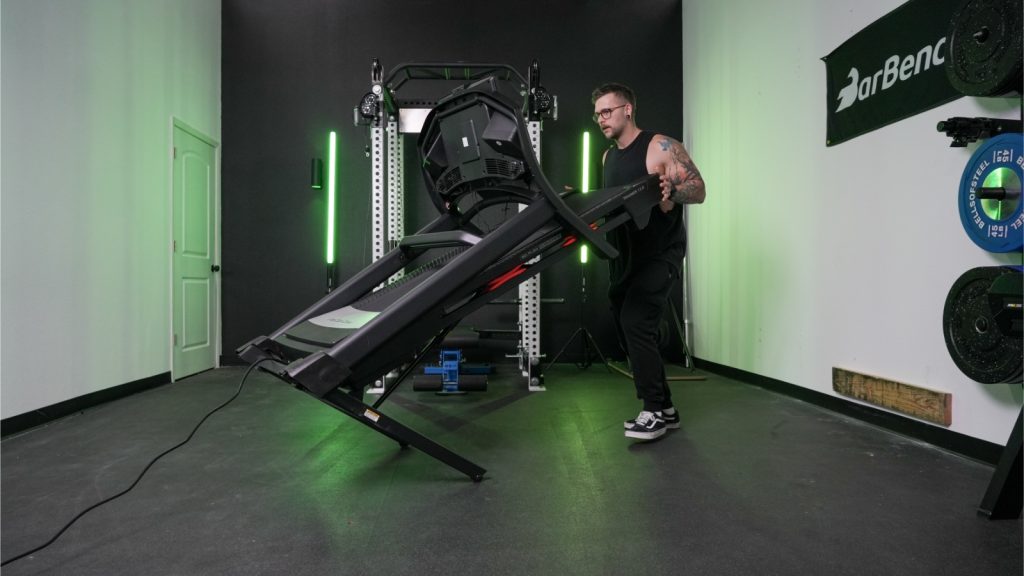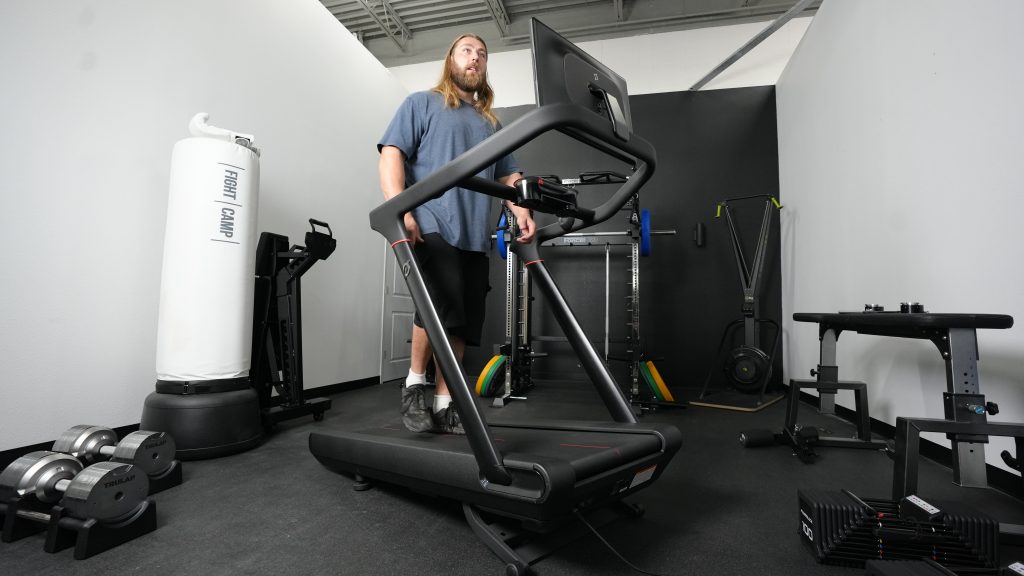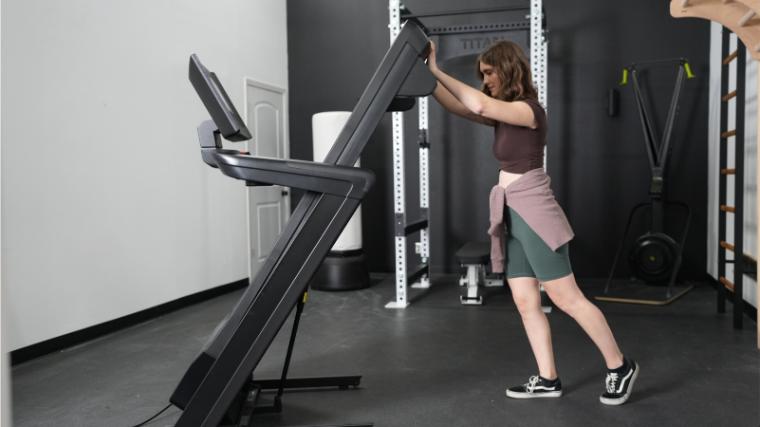You’ve done your research on the best treadmills and what home treadmill ownership requires, but have you thought about where to position your new cardio machine? If you have the convenience of having a home gym, the decision is a no-brainer — other than where to place it in your dedicated fitness space.
But if you don’t have a dedicated space for fitness equipment, you might be wondering where to put your new purchase. In addition to having enough room, you’ll want to consider factors like temperature, noise, flooring, privacy, ceiling heights, and accessibility when finding the prime location for your treadmill.
Home Treadmill Placement: Pros and Cons
Knowing where to position your treadmill is almost as important as the purchase itself. For example, if you purchased one of the best treadmills for running, you’ll want to be sure you position it somewhere you can run without distractions and not be a noise nuisance to other family members or roommates.
Let’s talk about common rooms where treadmill owners place their equipment and the pros and cons of each room.
Living Room or Den
Placing your treadmill in your main living space makes the exercise equipment more easily accessible and may encourage more frequent use. But because of its central location in your main living room, this could also be a hindrance or an eye sore.

If you live with others, chances are that no one wants to hear you pound the treadmill pavement while they’re trying to watch TV. In that case, you might want to check out our picks for the best quiet treadmills.
Below, we’ve listed out some of the pros and cons of placing your exercise equipment in your living room.
Pros
- It offers a visual reminder to exercise for both you and your family members.
- It’s climate-controlled.
- You can multitask during exercise, whether that’s watching TV or socializing.
Cons
- It can be visually unappealing and create distractions for family members
- You won’t get as much privacy during exercise as you would in a home gym, garage, or basement.
- Having a treadmill in your living space could be a potentially safety hazard for kids and pets.
Spare Bedroom
Spare bedrooms can serve as a great space to put your treadmill — unless you need the spare bedroom for a guest. Fortunately, there are tons of versatile options on the market for folding treadmills that can easily be stored away when your spare room or home office is needed.
With many Americans living in apartments, the market offers plenty of options for those living in smaller spaces. Luckily, we’ve done the research for you and compiled a list of the best treadmills for apartments.
When working with small spaces, getting creative in your spare bedroom with a folding treadmill can turn your spare room into a high-functioning, multi-purpose space.
“Few pieces of gym equipment are as iconic as the treadmill,” says BarBend expert reviewer Amanda Capritto, CPT, CES, CNC, CF-L1, CSNC. “In fact, treadmills are often the first things that come to mind when someone starts to consider exercising at home. However, not everyone has a large enough home to dedicate space to an entire home gym or even a permanent place for a treadmill. They are rather large and bulky, after all. Luckily, manufacturers have taken note and started producing more folding treadmill options. This allows you to free up floor space when you’re not using the treadmill, making a home exercise space more feasible for smaller homes.”
Here are some pros and cons of having your treadmill in your spare room.
Pros
- You’ll get more privacy in a spare room than you would in a common living space.
- Fewer distractions can mean better focus.
- It can be a good use of under-utilized space in your home.
Cons
- Having a treadmill in a spare bedroom can crowd potential guests.
- Smaller spare rooms can result in a lack of space for off-machine workouts.
Garage or Basement
A common place for a home treadmill is in a garage or basement. Personally, I prefer my treadmill to be in my climate-controlled garage where I can open up the door and let in the fresh air. It’s my happy place when I want to get my cardio in, and is away from my pets and kids. (If you have kids or pets, it’s a good idea to familiarize yourself with treadmill dangers and how to prevent them.)

Depending on your unique circumstances, a garage or basement could be the best (or worst) place for your treadmill. If either of these spaces has an extreme temperature — hot or cold — these are areas you want to avoid placing your treadmill in.
Certain warranties can be rendered void if the conditions aren’t met for proper treadmill placement. Icon Health and Fitness, a maker of well-known brands such as ProForm, NordicTrack, and Weslo, will void the warranty on their fitness equipment if it’s placed in a garage, covered patio, or near water. (1)
If you’re contemplating putting your treadmill in the garage or basement, check your specific model to learn about any factors that could void your warranty, and check out these pros and cons.
Pros
- Exercising in a garage or basement provides plenty of privacy and can help keep the noise down for housemates.
- It’s easy to keep children or pets at a distance.
- This can be a good use of an under-utilized space.
Cons
- If your garage or basement isn’t climate-controlled, it can result in temperature fluctuation or voided warranties.
- There tends to be more dirt and debris in these spaces than elsewhere in your home.
- These spaces tend not to be as accessible.
Measure, Measure, Measure!
Before you have your heart set on your treadmill location, grab your measuring tape to be sure there’s enough space in your new workout room. You’ll want to measure the length, width, and height of the room and the treadmill.
“Check the overall length, width, and height of the machine in its assembled position and folded position if applicable. And triple-measure your space to make sure it will fit,” says BarBend expert reviewer Amanda Capritto, CPT, CES, CNC, CF-L1, CSNC.
In addition to accounting for the length, width, and height of the room and your treadmill, here are some other important factors to consider:
- Power outlets
- Sloping floors
- Type of flooring
- Height of the folding deck in an upright position (if applicable)
- Additional space for safe use (see chart below)
- Surrounding items that could interrupt the operation of the treadmill belt
Floor Space
Having sufficient floor space for your fitness equipment will help ensure safe and comfortable use, and ultimately give you an enjoyable treadmill workout. Give yourself enough space for your workout routine, especially if you’re trying to create a functioning workout room in a small area.
If you’ve purchased a treadmill with interactive training — like the NordicTrack EXP 7i treadmill — many workout options might include off-treadmill training. You’ll want extra space to account for training that involves using floor space in your workout routine. (Who doesn’t like to mix a kettlebell in with their cardio?)
Necessary floor space can vary depending on your specific model, but here are some standard recommendations for having the right amount of room for your treadmill:
| Length | A total length of at least 6.5 to 7 feet (78 to 84 inches) is recommended to ensure ample space for walking, jogging, or running comfortably. |
| Width | Allocate enough space for the treadmill width and clearance on the sides for safe entry and exit. A total width of at least 3 to 4 feet (36 to 48 inches) is recommended to ensure enough space for safe operation. |
| Clearance | A minimum clearance of 2 feet (24 inches) on each side and at the rear of the treadmill is recommended for safe operation and maintenance. |
Ceilings
Don’t forget to check the height of your ceiling — especially if you’re tall — if you purchased a treadmill with a foldable deck or an incline feature.
[Related: The Best Treadmill Incline Workouts]
Generally speaking, a ceiling height of 7 to 8 feet is recommended, but check the specific recommendations of your manufacturer. Whatever the dimensions, you’ll want extra clearance on top of that.
Check out how the dimensions of these popular treadmills stack up against each other:
| Treadmill | Footprint |
| Peloton | 68” L x 33” W x 62” H |
| Nordictrack Commerical 1750 | 72.25″ L X 34″ W X 61″ H |
| NordicTrack EXP 7i | 70.8” L x 34.9” W x 59.7” H |
Doorways
A large piece of fitness equipment like a treadmill or elliptical can be awkward and heavy. When moving the machine through doorways, recruit a friend or family member to help navigate the sometimes difficult turns.
Before you move your equipment, check the width of each doorway you need to go through and make note of door swings. If the treadmill requires assembly, consider assembling it inside the room you’ll store it in.
If the treadmill is already assembled and won’t fit through the doorways, you may need to disassemble parts and then reassemble them once the equipment is in its permanent location.
To Fold or Not to Fold
If you have limited floor space to sacrifice but want to have the convenience of a home treadmill, a folding treadmill can provide a practical solution to save space in your home.

“Not everyone has a large enough home to dedicate space to an entire home gym or even a permanent place for a treadmill,” says BarBend expert reviewer Amanda Capritto, CPT, CES, CNC, CF-L1, CSNC. “They are rather large and bulky, after all. Luckily, manufacturers have taken note and started producing more folding treadmill options. This allows you to free up floor space when you’re not using the treadmill, making a home exercise space more feasible for smaller homes.”
Thankfully, the best folding treadmills on the market still offer many of the features found in standard models.
Final Thoughts
Treadmill placement can impact how often you use your treadmill and the quality of your workouts. What may seem like the perfect place to position your treadmill might be affected by a variety of factors that can hinder your workout.
Considering your unique living circumstances can help you sort through the pros and cons of your treadmill’s location. Once you’ve determined your treadmill’s home, be diligent in measuring the treadmill dimensions, floor space, ceilings, and doorways to prevent added frustration in moving your equipment. If you find that a treadmill just won’t work with your space, check out some of the best treadmill alternatives to satisfy your cardio needs.
Where to Position Treadmills FAQs
Where is the best place to put a treadmill?
The best place for your treadmill will be unique to your living situation and preferences. While the garage or basement is a popular location, it may not be advisable depending on temperature, space, warranty conditions, and more.
Should a treadmill face a wall?
Ultimately, whether a treadmill should face a wall or not is a matter of personal preference. There is no right or wrong answer other than following any safety precautions. Some individuals prefer the focus that the wall provides while others may find it boring. If possible, try different orientations to see what’s best for you.
Can I put a treadmill on a patio?
Assess factors such as available electrical outlets, security, noise, community living rules, flooring, and weather exposure before moving your treadmill on a patio. Take note that some warranties will be void if the conditions for treadmill placement aren’t met.
References
- Terms and Conditions. Retrieved April 23, 2024. Icon Health and Fitness. https://my.iconfitness.com/